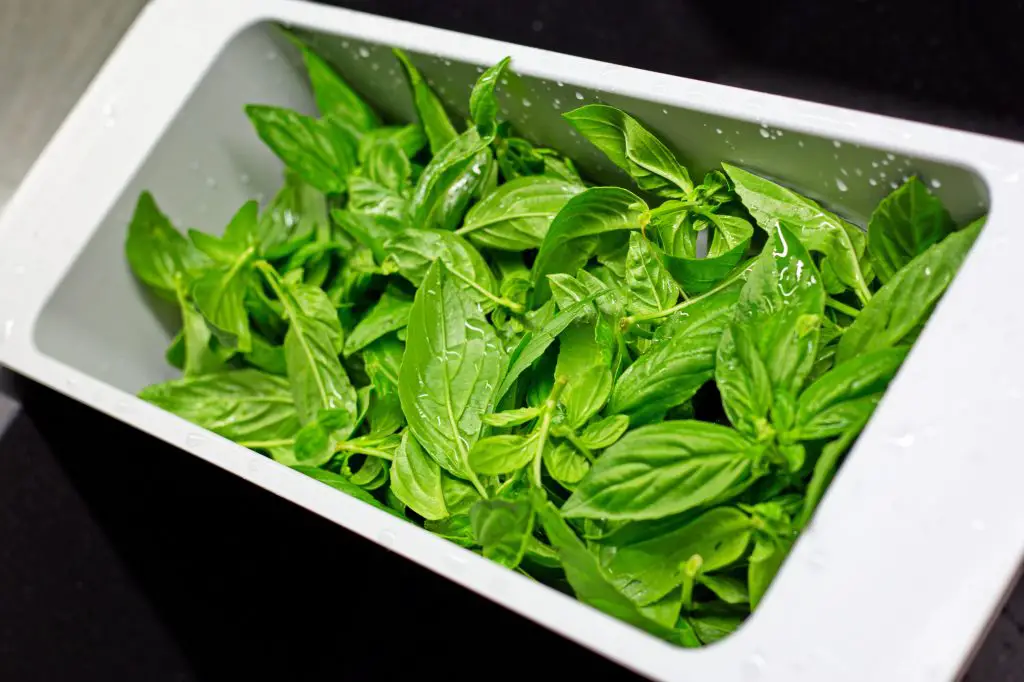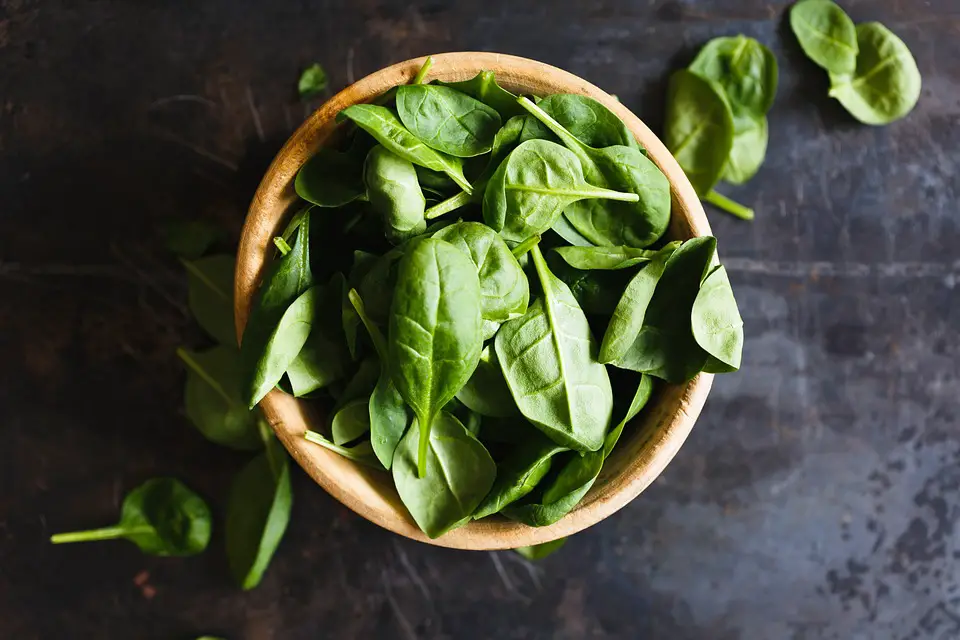If you’re interested in preserving your fresh basil for later use, you’ve come to the right place. There are several options for preserving your basil. You can vacuum seal it, blanch it, or dehydrate it before freezing it. You can even freeze it in ice cube trays.

If you grow more basil in your garden than you can consume while it is still fresh, the solution is to put the extra basil in the freezer so that you may continue to enjoy the taste of fresh basil throughout the entire year. Here are several distinct approaches to freezing it so it can be used throughout the year.
Different Ways to Freeze Basil
1. Blanched
I’m going to begin with, the technique of blanching and freezing fresh basil leaves because I’ve been told that this is the “official” way to do it. That is to say; if you search for instructions on how to freeze basil, you will most likely find this article at the top of the results.
Instructions for blanching basil leaves and freezing them:
- Basil should be washed and dried.
- Put some water in a pot, and get it boiling.
- Ice and cold water should be placed inside a huge bowl.
- Place the fresh basil leaves in a colander that can be placed inside the pot. Having the basil in something is crucial so it can be removed immediately and promptly.
- A few seconds are needed to submerge the colander with the leaves in the boiling water.
- After blanching, immediately place the leaves in the water bath containing ice.
- A salad spinner is used to dry the leaves after blanched (or pat them dry as best you can). This is the spinner I use and adore, and has the longest lifespan of any of the ones I’ve owned.
- Place on a cookie sheet and freeze for 12 to 24 hours until the mixture is firm.
Move fast after transferring the leaves to a freezer bag since they will begin to defrost as soon as they are exposed to room temperature.
2. Unblanched & Scattered Across the Tray
This is the approach I normally use when preserving berries or green beans, so it only made sense for me to test it out with basil, right? Of course, there is no difficulty whatsoever:
- Basil should be washed and dried.
- Place a single layer on a baking sheet and set aside.
- Freeze for 12 to 24 hours or until firm.
- Place the leaves in a freezer bag and squeeze out as much air as possible before sealing the bag.
3. Rolled Fresh Leaves in a Paper Towel
I became interested in this technique after reading about it in a remark posted on a website. The comment stated, “I have always rolled my basil in paper towel and then in Ziplock bag in the freezer.” I wanted to find out if the paper towel made a difference. I’m going to guess that it’s to sponge up excess moisture.
- Basil should be washed and dried.
- Place a single layer of leaves on a sheet of paper towel and then roll the towel up.
- Put the mixture into a gallon-sized freezer bag while pressing out as much air as possible (have you tried this tip before?) and become still.
4. Unblanched & Placed Directly Inside the Freezer Bags
Another approach I came across when reading a comment on a website that I went to is as follows: “Whenever I harvest my basil, I immediately place the leaves into freezer bags for use later. After being put in the freezer, I just remove what I need to use for cooking and chop it while it is still frozen. They keep that wonderful, fresh flavour throughout.”
Since this was an adaptation of my go-to technique for cooking without blanching, I couldn’t help but wonder how it would compare to how I normally prepare food on trays.
- Basil should be washed and dried.
- Put the leaves in bags for the freezer.
- Freeze the substance after pressing it to remove as much air as possible using either this method or another.
5. Chopped and Tossed in Oil to Coat
This method is well-liked on Pinterest, and it got me thinking about whether or not coating the leaves in oil will, in comparison to the other methods, aid in retaining the leaves.
- Basil should be washed, dried, and chopped.
- This is how it should be done: mix the leaves with a little olive oil and set aside (I used 3 cups of leaves to 2 tablespoons of oil).
- Put the portions in mason jars, and then freeze them.
6. Crumbled up into Liquid Cube Form
I have often read about preserving chopped leaves in liquid cubes (also for herbs in general), and I have done a version of it by processing leaves in a food processor, almost like making pesto, before adding them to ice cube trays. This has allowed me to preserve the leaves in a form that is easier to store (once in olive oil).
In the past, I had a hard time working with these cubes because I thought of them as a “one-shot wonder” that could only be used for marinara or pasta sauces (and since I usually have this amazing roasted sauce in the freezer, I hardly make it from scratch in the winter).
The following are some of the show methods differ from the ones I have tried in the past, and I found that these differences made this method more appealing to me:
- Basil should be washed, dried, and then sliced.
- To thoroughly cover the leaves, add either water or broth. Divide among the compartments of the ice cube tray (no blanching needed).
- Put into freezer bags that have been labelled and freeze until hard (or use ice cube trays with covers and store them in the trays).
How Long can Basil be Stored in the Freezer Before it Goes Bad?
The manual defrost freezer can keep frozen pesto for up to two years, and frozen basil leaves for eight months to a year. Even though the leaves may have lost some potency after eight months, I continue to utilise them (the problem is with the leaves’ quality, not their safety). You can read more about why this freezer is the best for keeping food here, even if it requires more work.
Can you Vacuum Seal and Freeze Basil?
Basil is a herb that can be vacuum-sealed and frozen to extend its shelf life. When frozen, it can be used in proportions similar to fresh herbs. Although the herb will lose some fresh flavour, it will still add flavour to your dishes. Before freezing, it is important to separate the stems from the leaves. Then, freeze it in ice cube trays or airtight containers.
Basil is a very delicate herb. When frozen, it will turn dark. You should avoid adding oil to the basil before freezing. If you want to use the basil later, do not add it to soups or stews. Added oil will spoil the flavour. You can add basil puree to your cooking, but it will not be as fresh as you like it.
Before you vacuum seal and freeze basil, you should thoroughly wash the leaves to remove dirt. Then, please put them in a plastic bag that is large enough to hold the herbs plus three inches. After that, use a vacuum sealer to seal the bag. Be sure to lay the leaves flat. Do not fill the bag more than 3/4 full, as this will interfere with sealing. You can then store the herbs in your freezer or anywhere else you prefer.
Can you Dehydrate Basil?
If you have a basil plant ready to harvest, you can freeze the fresh basil in small cubes and use them later in a recipe. Basil can be frozen without thawing; place the leaves in an airtight container or freezer bag and seal. You can label the container with the date you harvested the basil and store the cubes in the freezer.
Basil leaves are easy to freeze and have several nutritional benefits. Make sure to separate the leaves from the stems and wrap them in plastic or wax paper. Freeze the basil for at least 30 minutes before using it. You can also slice the leaves before freezing them. Afterwards, you can place the slices in silicone ice cube trays.
Once frozen, basil can be stored on a cookie sheet for up to a year. Just be sure to transfer the leaves quickly to prevent a freezer burn. To make basil fresh again, store it in an airtight container until the next garden harvest. Basil leaves can also be stored by boiling them in water, or you can use ice water to thaw them out quickly.
Can you Freeze Basil in Ice Cube Trays?
If you’re looking for a way to preserve basil conveniently, one option is to freeze it in ice cube trays. To prepare basil ice cubes, wash and dry the leaves thoroughly. Then, lay them flat on a baking tray lined with parchment paper. Freeze them for about 15 minutes. When they are frozen solid, remove them from the trays and store them in a freezer-safe bag. To add to your basil ice cubes, you can add crushed garlic, fresh chilli, and other herbs.
While a traditional way to freeze herbs requires a longer process, freezing basil is a convenient way to keep a large supply on hand for any recipe. Basil freezes well, keeping its fresh flavour in the freezer for up to six months. To prepare basil ice cubes, wash the leaves well to remove any dirt or insects. After washing the leaves, remove the stems. You can then roll them up and slice them. Place a few leaves per cube. Make sure to fill each cube about two-thirds full.
To prepare basil ice cubes, chop the leaves into fine pieces or place them in ice cube trays. If you choose to freeze your leaves, make sure to add a bit of olive oil to prevent them from blackening in the freezer. If you don’t want to use ice cube trays, you can freeze basil in a zip-top bag and store them in the freezer.
Conclusion
Basil is a versatile herb, and freezing it is a great way to preserve its flavour and nutrients. The process is very simple. First, blanch the basil leaves, then freeze them flat in an airtight container. Once frozen, transfer the basil to an airtight freezer bag.
Basil leaves can be frozen for up to a year. Before freezing, you need to blanch the leaves in boiling water. After that, transfer them to an ice bath. Freeze the basil until it becomes firm. This typically takes about 12 hours. Once frozen, transfer them to a freezer-safe bag and store them for up to two months.
You can also blanch basil leaves whole before freezing. First, you need to rinse the leaves thoroughly in cold water. You can use a salad spinner to do this. Next, place the leaves in a bowl of ice water for a few seconds to stop the cooking process. Then, you can place the frozen basil into a freezer bag.

